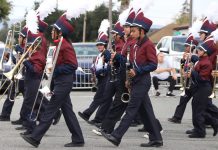Hollister
– Educators are examining the earliest data available on student
performance for children enrolled in Spring Grove’s Reading and
Math Academy program, a first-of-its-kind effort to catch students
who traditionally fall through the cracks.
Hollister – Educators are examining the earliest data available on student performance for children enrolled in Spring Grove’s Reading and Math Academy program, a first-of-its-kind effort to catch students who traditionally fall through the cracks.
“Conceptually, this is a very sound program,” Interim Principal/Superintendent Evelyn Muro said. “I feel very good about what we’re doing, but these things take time.”
Spring Grove’s Math and Reading Academy, founded in the beginning of the fall semester last year, is targeted toward students who need extra attention in those two basic areas, and are recommended by their teachers to participate. Both students and parents sign an agreement committing the student to leave his regular class and join the academy, where he’ll receive intensive instruction in both subjects every day.
“Overall I think the program is going very well,” said Susan Stoner, who teaches one of the academy classes. “We’re able to control class size, how much individual instruction certain students need, how big the groups they work in are. We can give these kids what they need to be successful.”
Academy students have been grouped into a fourth- and fifth-grade combined class or one for junior high aged students in the sixth, seventh and eighth grades, and class size is capped at 20. The program has grown and this year Spring Grove added a class for first- and second-graders, and a third-grade class as well.
“I think there’s a lot of parent support for this program,” Trustee Bob Bernosky said. “As a board member I haven’t heard one negative comment from a parent.”
Educators have only recently had an opportunity to examine the Standardized Testing and Reporting (STAR) exam scores from the first group of academy students. The STAR exam is a battery of tests designed to ensure that students are meeting state standards in English, math and – for older students – social studies and science.
“The results are mixed,” Muro said. “On one hand, some students have been extremely successful, but other students haven’t made that sort of progress. So now is the time to look at what we’re doing so we can see those results for all students.”
Students’ STAR scores are used to classify them as far below basic, below basic, basic, proficient or advanced in a given subject. Most, if not all, academy students were at basic or lower when they started the program last year. But several students have jumped up as much as two classifications – for example from far below basic to basic – over the course of the year. A few have been identified as proficient. Three students were graduated from the academy program and have been placed in conventional classrooms this year, but the results for other students have been more modest.
“We had a few other students we considered moving up, but decided to keep them in the academy class just to make sure they’re getting the support they need,” Assistant Principal Kathleen Kilday said.
Muro hastened to point out that one batch of test scores is no way to judge the success or failure of the program, which may be one of a kind in California as Spring Grove educators have not identified schools using a similar program.
“We’re all learning about this as we go,” she said. “And we’re going to be working with this data for the rest of the year. This is the most critical time for a new program like this and whether it is successful or fails depends on the effort we put in.”
Muro said a more in-depth report would be available at the next school board meeting.
Danielle Smith covers education for the Free Lance. Reach her at 637-5566, ext. 336 or ds****@***********ws.com.









